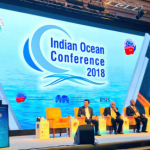In the annals of modern Asian history, Vietnam is unique. Over the last century, it has absorbed assault by three major military powers – the French, Americans and Chinese – stayed resilient, and is now, independent. But it is only in the last few years that it has emerged as an important player in the Indo-Pacific region – and is being seen as a strong counterpoint to the Chinese assertions in South East Asia.
It was therefore appropriate that on August 27-28, Hanoi played host to the India Foundation’s Indian Ocean Conference 2018.
This conference, now in its third edition, is not as glamorous and high-octane – not as yet – as the Shangri-La Dialogue, hosted annually by Singapore and the International Institute for Strategic Studies, which has admirals, generals and ministers from western countries talking to Asia. But the Indian Ocean Conference is more real, a venue where Asia can talk to Asia, as an equal, about the immediate security issues that concern them all acutely.
The theme for this year’s conference was Building Regional Architectures – a step beyond last year’s conference theme of Peace, Progress & Prosperity. India’s goal was clearly to step up to its responsibility as a serious Indo-Pacific player. This was clearly enunciated at the inauguration by External Affairs Minister Sushma Swaraj, when she said that India is devoting more resources to and prioritising connectivity in its immediate neighbourhood while also expanding the interpretation of what constitutes India’s neighbourhood.
The two-day conference saw a larger number of diplomats, stars in uniform, foreign and defence ministers and higher representation, in general, showing how seriously it is being taken.
It was clear that the Asian maritime nations expect India to take on a larger leadership role in three areas: the Security and Growth for all in the Region (SAGAR) initiative, looking beyond the Quadrilateral, and investments to counter China’s domineering presence.
While India’s vision on SAGAR has come to be appreciated by the countries of the Indian Ocean Region (IOR), conversations on the sidelines of the conference made clear that they are now eager to see India implement this vision. A first step towards this can be working together with these countries for port development, maritime tourism and the Blue Economy.
The Quadrilateral initiative – consisting of India, the U.S., Australia and Japan – which was revived last year, has been projected as an attempt towards regional maritime security collaboration, but smaller littoral states of the Indo-Pacific feel left out – given that they are on the front lines of the disputes with China, terrorism, maritime piracy, transnational organised crime etc. They want acknowledgement and clear participation in the managing of maritime affairs. Their contention: many small states of the IOR don’t have the technology or skills to check the illicit activities at sea of criminal networks and aggressive state actors like China. So, they want more legal enforcements, such as greater commitment towards the UN Convention on the Law of the Seas, and the larger Quad countries to share maritime domain awareness information.
Lastly, there was China and its multi-billion dollar push in the Asia Pacific through the Belt and Road Initiative. There is a greater awareness of being trapped by China’s investments and subsequent debt; but the alternatives are not forthcoming. Countries like Sri Lanka have expressed helplessness in accepting Chinese investment given their domestic infrastructure financing needs. Sri Lankan Prime Minister Ranil Wickremesinghe emphasised that it is important to understand the host country’s needs for infrastructure financing, economic growth and Foreign Direct Investment, which will in turn directly contribute to the prosperity of the region.
Viable policy alternatives are becoming increasingly visible: Alice Wells, American principal deputy assistant secretary for South and Central Asia said that U.S. private companies could step back into this investment space as before. She said, “Only the private sector can provide the estimated $26 trillion needed by 2030 for infrastructure investment in Asia.” She cited as example the contribution of American companies, such as Chevron, GE and SpaceX, to the Bangladeshi economy.
India is central to many of these endeavours, which will create the building blocks of a governance architecture in the Indo-Pacific even as the region remains an arena of continued geopolitical contestation.
Sameer Patil is Director, Center for International Security and Fellow, National Security Studies, Gateway House.
This blog was exclusively written for Gateway House: Indian Council on Global Relations. You can read more exclusive content here.
For interview requests with the author, or for permission to republish, please contact outreach@gatewayhouse.in.
© Copyright 2018 Gateway House: Indian Council on Global Relations. All rights reserved. Any unauthorized copying or reproduction is strictly prohibited.


